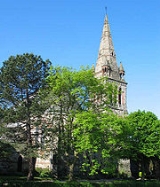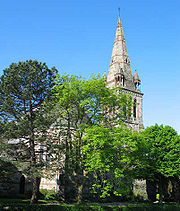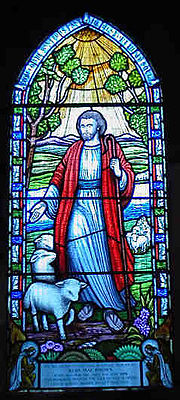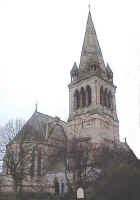
St Thomas' Church, Belfast
Encyclopedia

- For other churches with the same or similar name, please see St. Thomas' ChurchSt. Thomas' ChurchSt. Thomas Church, St. Thomas Chapel, or variations may refer to:in China*St. Thomas the Apostle Church, Hong Kongin England*Cathedral Church of St Thomas of Canterbury, commonly known as Portsmouth Cathedral*Sts Thomas Minster, Isle of Wight...
.
St Thomas' Parish, in south Belfast
Belfast
Belfast is the capital of and largest city in Northern Ireland. By population, it is the 14th biggest city in the United Kingdom and second biggest on the island of Ireland . It is the seat of the devolved government and legislative Northern Ireland Assembly...
, Northern Ireland
Northern Ireland
Northern Ireland is one of the four countries of the United Kingdom. Situated in the north-east of the island of Ireland, it shares a border with the Republic of Ireland to the south and west...
, is part of the Church of Ireland
Church of Ireland
The Church of Ireland is an autonomous province of the Anglican Communion. The church operates in all parts of Ireland and is the second largest religious body on the island after the Roman Catholic Church...
, which is a member Church of the world-wide Anglican Communion
Anglican Communion
The Anglican Communion is an international association of national and regional Anglican churches in full communion with the Church of England and specifically with its principal primate, the Archbishop of Canterbury...
.
St Thomas' Church is located at the end of Eglantine Avenue near the Lisburn Road, one of Belfast's main arterial routes. The Parish extends from Elmwood Avenue to Adelaide Park, and from the Malone Road
Malone Road
The Malone Road is a radial road in Belfast, Northern Ireland, leading from the university quarter southwards to the affluent suburbs of Malone and Upper Malone, each a separate electoral ward...
to the Lisburn Road.
Architecture
The part of Belfast south of Queen's University between the Malone and Lisburn roads, known as the 'Malone Ridge', underwent rapid expansion from the middle of the 19th century, as a prosperous and fashionable suburb of large detached villas and grand terraces. At the time, the Church of Ireland presence in this area was limited to the old Malone Church, as well as Christ Church in College Square, neither of which was deemed an appropriate place of worship. Following a generous bequest by Andrew Thomas McLean for the endowment and construction of a new parish church, the architect John Lanyon of Lanyon, Lynn and LanyonLanyon, Lynn and Lanyon
Lanyon, Lynn & Lanyon, Civil Engineers and Architects was a 19th-century firm working mainly in Dublin and Belfast, and the leading architectural firm in Belfast during the 1860s. Its partners were Charles Lanyon, William Henry Lynn, and Charles' son John Lanyon.Charles Lanyon was the head of the...
, then Belfast's leading architectural practice, was appointed in 1866. Building work commenced in 1869 and St Thomas's was consecrated on 22 December 1870.
The same year had seen the completion of Belfast Castle
Belfast Castle
Belfast Castle is set on the slopes of Cavehill Country Park, Belfast, Northern Ireland in a prominent position above sea level. Its location provides unobstructed views of the city of Belfast and Belfast Lough.-History:...
by the same practice. Other notable examples of their then recent work in the city included Clarence Place in May Street (now occupied by Lambert Smith Hampton), Richardson Sons and Owden's warehouse in Donegall Square North (now part of Marks & Spencer) and the main building at Queen's University (now called the Lanyon Building).
On a grand scale and designed to impress, St Thomas's is one of the grandest and most fully finished examples of High Victorian Gothic ecclesiastical architecture, not only in Belfast, but in Ulster
Ulster
Ulster is one of the four provinces of Ireland, located in the north of the island. In ancient Ireland, it was one of the fifths ruled by a "king of over-kings" . Following the Norman invasion of Ireland, the ancient kingdoms were shired into a number of counties for administrative and judicial...
. Inside the Church, cool monumentality gives way to warmth and richness. Built of white Scrabo sandstone with finely dressed masonry round doors and windows, it is adorned with red sandstone banding and coloured marble discs and colonnettes to the tower and spire. The exterior is a confident exercise in eclectic design: generally the style is Early French Gothic, but the polychrome effects point to an Italian Gothic influence. There may also be an Early Christian Irish reference in the round stone-capped stair turret. The date 1870 is inscribed over the North doorway. Probably because of constraints imposed by the sloping site, the orientation of St Thomas' is unusual, the chancel facing North. In 1888 the church was enlarged at the South end, to a John Lanyon design, when the South West porch was added, as well as the internal gallery with its Gothic timber stairway. Along with the increase in the length of nave and aisles, this extended the seating capacity
Seating capacity
Seating capacity refers to the number of people who can be seated in a specific space, both in terms of the physical space available, and in terms of limitations set by law. Seating capacity can be used in the description of anything ranging from an automobile that seats two to a stadium that seats...
to over 1,000.

Internal features
The capital above the pulpit with its four heads of angels is more delicately executed than the rest and is the only one on which figures appear. Carvings of the symbols of the four Evangelists - man, lion, ox and eagle - can be seen in the chancel next to the windows of Saints Matthew, Mark, Luke and John, which flank St Thomas and St Paul in the two central lancetLancet window
A lancet window is a tall narrow window with a pointed arch at its top. It acquired the "lancet" name from its resemblance to a lance. Instances of this architectural motif are most often found in Gothic and ecclesiastical structures, where they are often placed singly or in pairs.The motif first...
s and there is finely carved tracery on the wall panels as well as on the oak altar. The stone pulpit is fairly heavy in style but elaborately ornamented. Attractive original wrought iron light fittings are still in use in the nave. Eight modern roundels on the chancel wall to the left and right of the altar are symbolic representations of aspects of the Holy Communion.
There are many very fine stained-glass windows throughout the Church, about 45 windows and panels in all.
Much of the pre-war glass is by Heaton, Butler and Bayne of London
London
London is the capital city of :England and the :United Kingdom, the largest metropolitan area in the United Kingdom, and the largest urban zone in the European Union by most measures. Located on the River Thames, London has been a major settlement for two millennia, its history going back to its...
. The greater number of the windows depict scenes from the life of Christ and familiar Biblical passages, such as the Parable of the Sower and the Parable of the Talents. The Resurrection also figures prominently. A plan of the windows, with explanations, is available in the church.
The Hill organ
Organ (music)
The organ , is a keyboard instrument of one or more divisions, each played with its own keyboard operated either with the hands or with the feet. The organ is a relatively old musical instrument in the Western musical tradition, dating from the time of Ctesibius of Alexandria who is credited with...
of 1874 was enlarged by its builder in 1906, but has remained essentially unaltered since then, which makes it an instrument of considerable and national significance.
The peal of eight bells in the tower, ranking in quality and tone among the finest in these islands, was presented by Robert Atkinson of Beaumont, Malone Road, in 1870. They are notorious for waking up the citizens of Belfast every Sunday morning at 10 am.
Rectory
The adjacent RectoryRectory
A rectory is the residence, or former residence, of a rector, most often a Christian cleric, but in some cases an academic rector or other person with that title...
was also designed by Lanyon, Lynn and Lanyon and built in 1871. A fine red brick residence, this is also decorated with bands of contrasting colour. Above the front door is an attractive sandstone carving of an angel playing a lute.
The current Rector is the Revd Walter Lewis, who is also the Rural Dean for South Belfast.
Pew rental

Pew
A pew is a long bench seat or enclosed box used for seating members of a congregation or choir in a church, or sometimes in a courtroom.-Overview:Churches were not commonly furnished with permanent pews before the Protestant Reformation...
rental system meant that only 158 seats were free for those who could not afford to rent. An extension was proposed and completed in 1888 providing another 266 seats. At that time, pew rentals provided a dependable source of income for a church. In 1891 they could vary from £1.37 per sitting per annum to 75 pence for the less popular parts of the Church. In 1898, the pew rents amounted to £797 out of a total income of £1700. They were eventually abolished in 1947.
Organisations
By 1892, in addition to the existing day school, St Thomas's had established a Sunday SchoolSunday school
Sunday school is the generic name for many different types of religious education pursued on Sundays by various denominations.-England:The first Sunday school may have been opened in 1751 in St. Mary's Church, Nottingham. Another early start was made by Hannah Ball, a native of High Wycombe in...
, a Teachers' Meeting, a Zenana working party, a Gleaners' Union, a Society of Bellringers, a coal fund, a penny bank, a temperance society, a Boys' Brigade
Boys' Brigade
For the 80s New Wave band from Canada, see Boys Brigade .The Boys' Brigade is an interdenominational Christian youth organisation, conceived by William Alexander Smith to combine drill and fun activities with Christian values...
company and a Literary Society. The Church of England Zenana Missionary Society was amalgamated with the Church Missionary Society in 1957.

